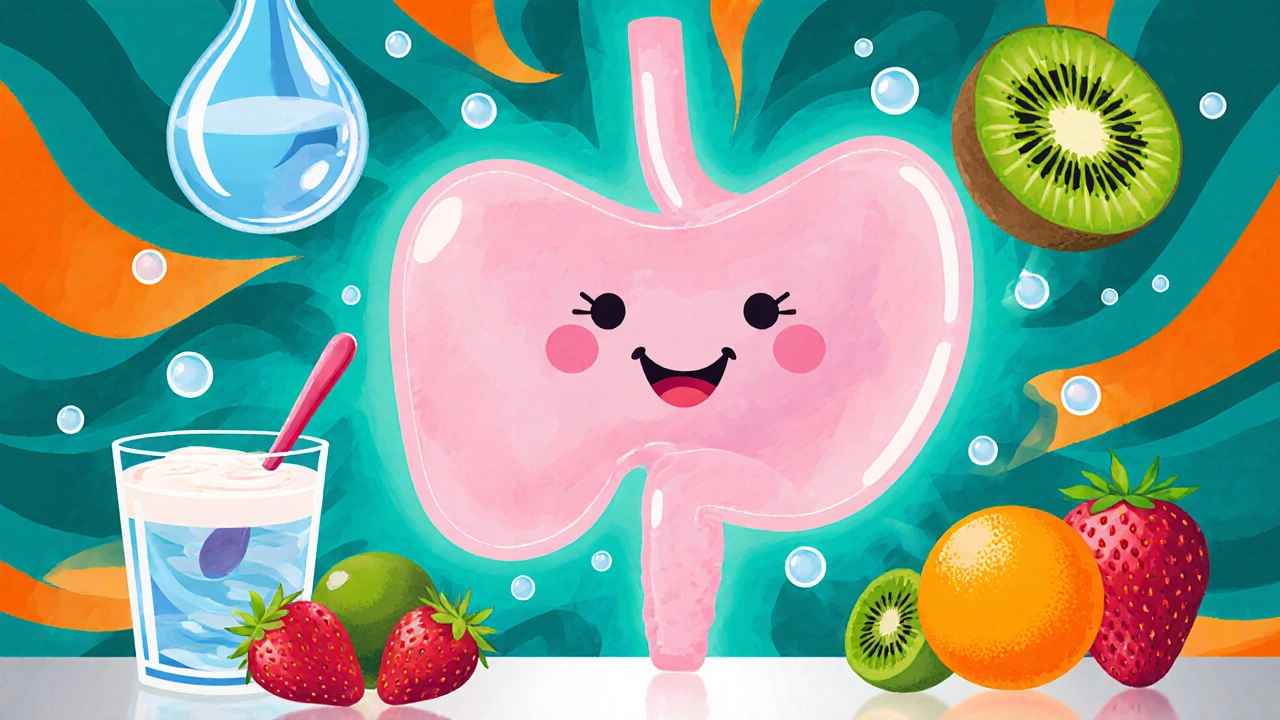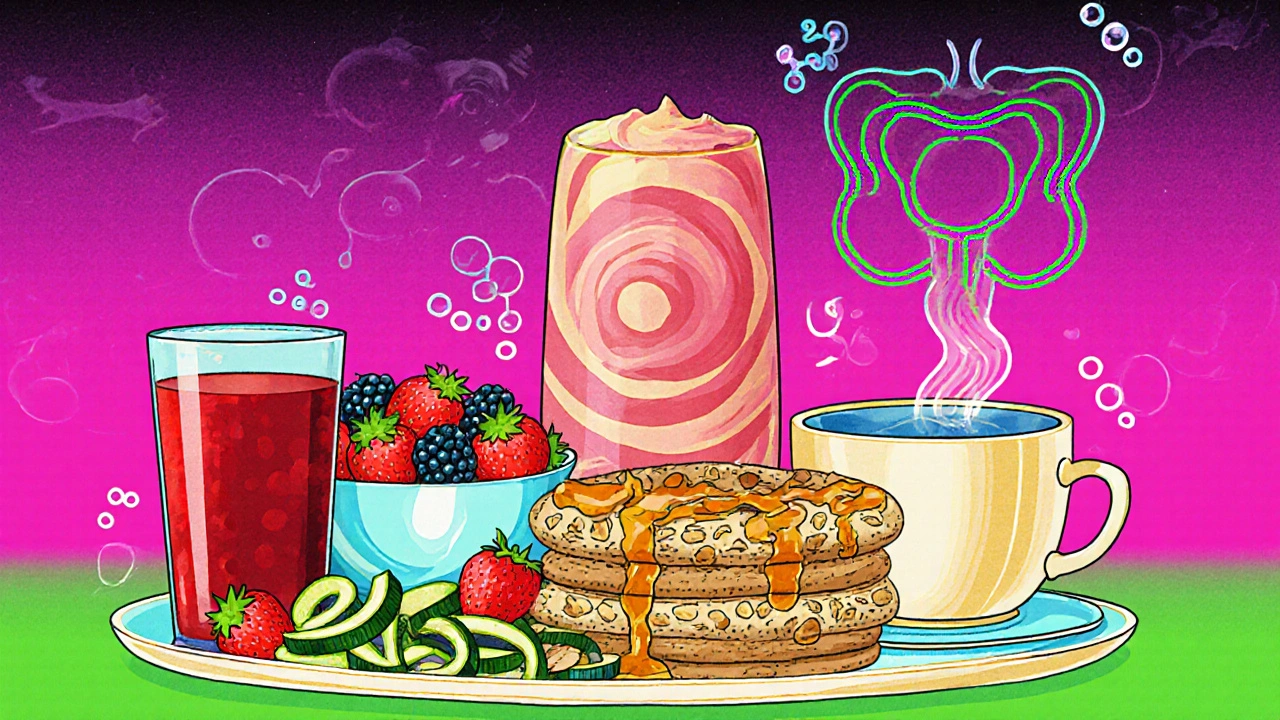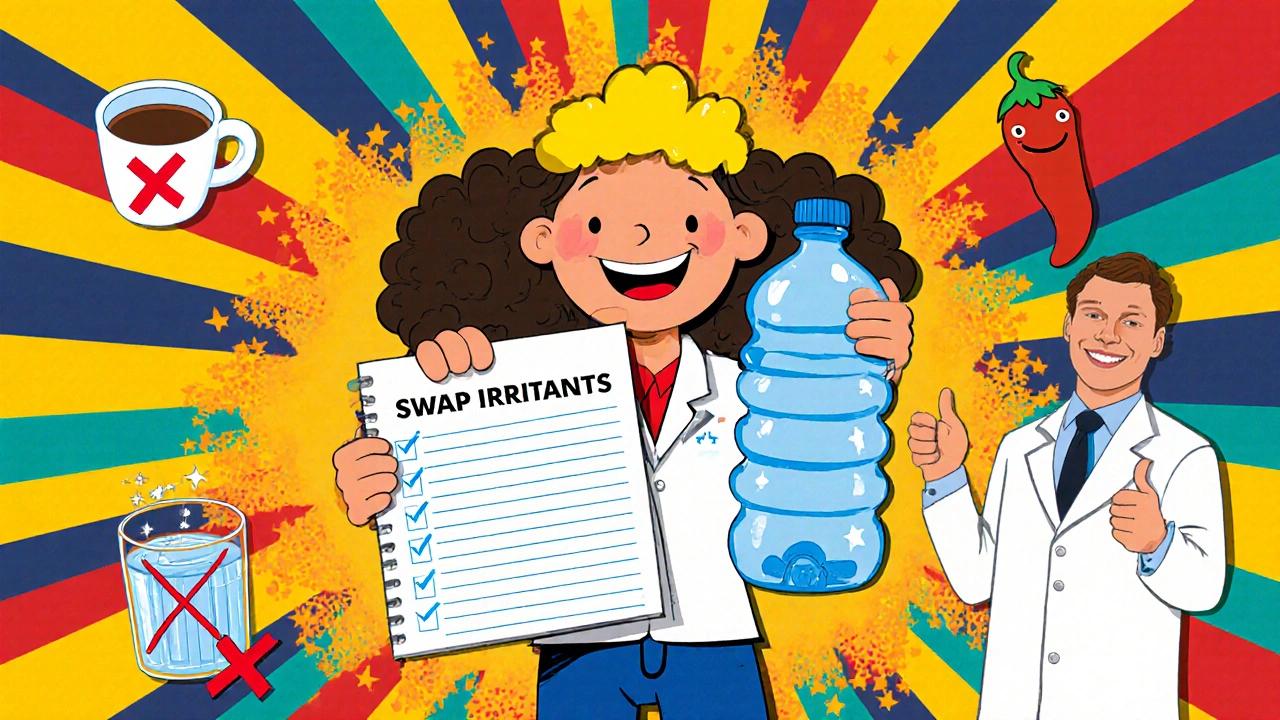How Diet Can Prevent & Manage Cystitis - Practical Nutrition Guide

Cystitis Diet Score Calculator
How Your Diet Scores for Bladder Health
Track your daily food choices against cystitis-friendly guidelines. The higher your score (5 = best), the more supportive your diet is for urinary health.
Add Your Foods
Your Daily Score
of 5.0
Key Foods in Your Day
When it comes to bladder health, what you eat often matters more than you realize. Cystitis is a type of urinary tract infection that inflames the bladder lining, causing burning urination, frequent urges, and sometimes blood in the urine. While antibiotics treat the infection, diet can play a big role in both preventing flare‑ups and easing symptoms once they appear. Below you’ll find a step‑by‑step guide that shows exactly which foods to embrace, which to ditch, and how to build a daily routine that supports a healthy urinary tract.
Quick Takeaways
- Stay hydrated - aim for at least 2 L of water daily.
- Include cystitis diet staples like cranberry juice (unsweetened), probiotic yogurt, and vitamin C‑rich fruits.
- Avoid bladder irritants such as spicy peppers, caffeine, alcohol, and artificial sweeteners.
- Balance your meals with low‑acid, high‑fiber options to keep urine pH stable.
- Track triggers in a simple food‑symptom diary for personalized adjustments.
Understanding Cystitis and Why Diet Matters
At its core, cystitis occurs when bacteria-most often E. coli-colonize the urethra and travel up into the bladder. The lining becomes inflamed, and the body reacts with pain and frequent urges. Certain dietary habits can create an environment that either fuels bacterial growth or helps flush it out.
Two key mechanisms link food to bladder health:
- Urine pH and acidity: Acidic urine can irritate the bladder wall, making it easier for bacteria to adhere. Alkaline‑forming foods (e.g., many vegetables) help keep pH in a gentler range.
- Fluid composition: Sugar‑laden drinks, caffeine, and alcohol increase urine concentration and can foster bacterial colonies. Water‑rich, low‑sugar beverages dilute urine and assist the kidneys in flushing toxins.
Beneficial Foods for a Cystitis‑Friendly Diet
Below is a quick‑reference table that ranks common foods based on their impact on bladder health. The scoring is a simple 1‑5 scale, where 5 means “highly supportive.”
| Food | Benefit Score | Why It Helps |
|---|---|---|
| Cranberry juice (unsweetened) | 5 | Contains proanthocyanidins that prevent bacteria from sticking to bladder walls. |
| Probiotic yogurt or kefir | 4 | Promotes healthy gut flora, reducing the reservoir of harmful bacteria. |
| Vitamin C‑rich fruits (orange, kiwi, strawberries) | 4 | Acidifies urine slightly, creating an environment less hospitable to E. coli. |
| Water‑rich vegetables (cucumber, lettuce, zucchini) | 5 | Boosts hydration and supplies antioxidants that soothe bladder lining. |
| Whole grains (brown rice, oats) | 3 | Fiber keeps bowel movements regular, limiting bacterial back‑flow. |
| Herbal teas (chamomile, peppermint) | 3 | Gentle diuretics that increase urine flow without caffeine. |
In practice, make these foods a daily staple. A morning smoothie with kale, cucumber, a splash of unsweetened cranberry juice, and a dollop of probiotic yogurt hits almost every benefit category at once.

Common Irritants to Limit or Eliminate
Even if you love a certain snack, it might be sabotaging your bladder. Here’s a short list of typical culprits and the science behind their impact.
- Spicy peppers and hot sauces: Capsaicin can inflame the urothelium, heightening pain during urination.
- Caffeine (coffee, black tea, energy drinks): Acts as a mild diuretic, increasing frequency and irritating the bladder wall.
- Alcohol: Dehydrates you and can alter urine pH, making infections more likely.
- Artificial sweeteners (aspartame, sucralose): Some studies link them to changes in gut microbiota, indirectly affecting urinary health.
- Acidic fruits (tomatoes, citrus in excess): Over‑acidic urine can irritate the bladder lining, especially in sensitive individuals.
If you notice a symptom spike after a particular food, note it in a diary and experiment with a short elimination period (7-10 days). Most people find relief by cutting back on one or two of these items.
Putting It All Together: Sample Day on a Cystitis‑Friendly Plate
- Breakfast: Oatmeal topped with fresh berries, a drizzle of honey, and a side of kefir. Follow with a glass of water infused with a few cucumber slices.
- Mid‑morning snack: An orange and a handful of unsalted almonds. Drink another 250 ml of water.
- Lunch: Mixed green salad with spinach, zucchini ribbons, grilled chicken, and a vinaigrette made from olive oil, lemon juice (in moderation), and herbs. End with 150 ml of unsweetened cranberry juice.
- Afternoon boost: Herbal chamomile tea and a small serving of probiotic yogurt.
- Dinner: Baked salmon, quinoa, and steamed broccoli. Finish with a glass of water and, if you like, a low‑caffeine green tea.
- Evening: Warm water with a slice of lemon (if tolerated) and a final bathroom trip before bed.
This plan hits every high‑score food from the table, keeps fluids steady throughout the day, and avoids known irritants. Adjust portion sizes to your calorie needs, but keep the core principles intact.
Common Pitfalls & How to Avoid Them
Even with a solid plan, people often stumble on small habits that undo progress.
- “I’m drinking enough because I’m sipping coffee.” Caffeine increases urine output but also irritates the bladder. Replace one cup with water.
- “I only need to drink when I’m thirsty.” Thirst is a late signal. Aim for a set volume (e.g., 2 L) rather than reactive drinking.
- “I love sugary sports drinks after workouts.” The sugar fuels bacterial growth. Opt for plain electrolyte water or coconut water without added sugars.
- “I can’t skip my favorite spicy Mexican dinner.” Try milder versions-use paprika instead of jalapeños, and keep the sauce on the side.
Addressing these habits often yields noticeable symptom relief within a week.

Frequently Asked Questions
Frequently Asked Questions
Can cranberry juice cure cystitis?
Cranberry juice can help prevent bacteria from adhering to the bladder wall, but it isn’t a cure. It works best as a preventive measure alongside adequate hydration and, when needed, medical treatment.
How much water should I drink daily to reduce cystitis risk?
Aim for at least 2 liters (about 8 cups) of plain water a day. If you’re active, live in a hot climate, or sweat a lot, increase that amount accordingly.
Are probiotics really effective for urinary health?
Research shows certain strains (e.g., Lactobacillus rhamnosus GR-1 and Lactobacillus reuteri RC-14) can lower recurrence rates of UTIs by balancing gut flora. Including probiotic foods or supplements can be a useful adjunct.
Is it safe to rely only on diet without antibiotics?
If symptoms are mild and you’ve had a confirmed diagnosis, some clinicians may let you try a short course of dietary measures while monitoring. However, most cystitis cases benefit from antibiotics to clear the infection quickly and avoid complications.
Can I eat fruit if it’s too acidic?
Moderate intake is fine; the key is balance. Pair acidic fruit with alkaline foods (like leafy greens) and keep overall fluid intake high to dilute any irritating effect.
Next Steps: Personalizing Your Bladder‑Friendly Routine
1️⃣ Start a food‑symptom log: Write down everything you eat and any bladder changes you notice. After two weeks, identify patterns.
2️⃣ Hydration audit: Track water intake with a simple phone app. Set hourly reminders if you tend to forget.
3️⃣ Gradual swap: Replace one irritant per week-swap soda for sparkling water, replace coffee with tea, or cut back on spicy sauces.
4️⃣ Consult a professional: If symptoms persist more than three days despite dietary tweaks, see a GP or urologist for testing and appropriate antibiotics.
By treating diet as a daily tool rather than a one‑off fix, you give your urinary tract a solid defense against infections and keep uncomfortable flare‑ups at bay.
Tracy O'Keeffe
October 18, 2025 AT 20:03The so‑called ‘practical nutrition guide’ reads like a litany of culinary clichés masquerading as medical advice.
One cannot help but notice the relentless penchant for buzz‑word salad, where ‘hydro‑balance’ and ‘micro‑biome synergism’ are tossed around with reckless abandon.
Cranberry juice is praised as a panacea, yet the author neglects to mention the staggering variability in proanthocyanidin content across brands.
Furthermore, the recommendation to drink ‘at least 2 L of water daily’ fails to account for individual renal thresholds and electrolyte homeostasis.
The dietary exclusions list-spicy peppers, caffeine, alcohol-appears to be compiled from a generic list of irritants rather than a nuanced appraisal of dose‑response relationships.
A true evidence‑based protocol would cite randomized controlled trials, not anecdotal tables scored on a whimsical 1‑to‑5 scale.
The inclusion of vitamin C–rich fruits as a ‘acidifier’ paradoxically contradicts the earlier claim that acidic urine irritates the bladder.
One also wonders why the guide omits discussion of glycemic load, a factor that can influence bacterial growth via urinary glucose excretion.
The prose drips with pretentiousness, as if the reader must be inducted into a culinary cult before they can simply stay hydrated.
Mis‑spellings such as ‘definately’ and ‘recieve’ pepper the text, undermining the supposed professionalism.
Moreover, the suggestion to “track triggers in a simple food‑symptom diary” lacks any methodological guidance on statistical significance.
The promised “rapid symptom relief within a week” is a claim that feels more like a marketing slogan than a realistic therapeutic timeline.
While the table of ‘beneficial foods’ is aesthetically pleasing, it offers no insight into bioavailability or the impact of cooking methods.
A reader seeking genuine bladder health advice would benefit more from a discussion of urinary pH buffering agents than from a list of cucumber‑laden salads.
In short, the guide is an elegant collage of half‑truths, culinary hype, and vague exhortations that leave the scientifically curious dissatisfied.
One might as well replace the entire manuscript with a single sentence: drink water and consult a physician.
Rajesh Singh
October 25, 2025 AT 02:43The moral imperative behind dietary stewardship is often downplayed, yet we bear a responsibility to nourish our bodies with evidence, not hype. It is disheartening to see a guide that skirts scientific rigor while preaching health. While I appreciate the intent to help those suffering from cystitis, the advice borders on wishful thinking. Readers deserve transparency about what truly works versus what is anecdotal. A balanced approach that couples proper hydration with medical consultation is the ethical path forward. Let us not sacrifice truth on the altar of trendy nutrition.
Albert Fernàndez Chacón
October 31, 2025 AT 08:23Thanks for sharing this overview. The suggestions about water intake and probiotic foods are solid basics. I’ll try incorporating the smoothie idea into my routine.
kendra mukhia
November 6, 2025 AT 15:03Honestly, the article glosses over the complexities of urinary pH regulation. The claim that ‘vitamin C acidifies urine’ ignores the buffering capacity of the kidneys. Moreover, the exclusion list is overly broad; not everyone reacts to a dash of caffeine. If you’re serious about a cystitis‑friendly diet, you need to personalize the plan based on lab results. My experience shows that tracking urine pH with strips can reveal hidden triggers that the guide never mentions.
Sarah Hanson
November 12, 2025 AT 21:43I concur with the need for personalization. Please consider adding a simple template for a food‑symptom log.
Nhasala Joshi
November 19, 2025 AT 04:23Wake up, the water you drink is being poisoned by hidden sugars 😱. The establishment never tells you about the fluoride conspiracies in municipal supplies.
Linda A
November 25, 2025 AT 11:03From a philosophical standpoint, the body is a micro‑ecosystem where balance precedes intervention. The guide’s emphasis on elimination mirrors a punitive mindset rather than a harmonious one. By fostering probiotic diversity, we nurture the gut‑bladder axis naturally. It is a subtle dance, not a battle.
Joe Moore
December 1, 2025 AT 17:43Yo that table looks slick but it’s missing the real culprits like high‑fructose corn syrup. Also, the whole ‘avoid artificial sweeteners’ thing is overblown, many ppl tolerate them fine. Anyway, keep it real, don’t just copy‑paste the guide.
Poornima Ganesan
December 8, 2025 AT 00:23Let’s get straight to the point: you cannot treat cystitis solely with diet. Antibiotics remain the cornerstone of therapy; diet is merely adjunctive. The article’s romanticized view of cranberry juice ignores the fact that many commercial brands are loaded with added sugars, which can actually promote bacterial growth. Hydration is crucial, but drinking random herbal teas without caffeine isn’t a magic bullet. A realistic plan should integrate medical treatment, dietary support, and lifestyle modifications like proper bathroom habits. Ignoring any of these components sets you up for recurrent infections.
Emma Williams
December 14, 2025 AT 07:03That’s a helpful summary
Stephanie Zaragoza
December 20, 2025 AT 13:43While I appreciate the brevity of the previous comment, it should be noted, with ample punctuation, that oversimplification can mislead readers; a single-sentence overview lacks the nuance required for medical nutrition therapy, especially when dealing with urinary tract infections, which demand a comprehensive, evidence‑based approach; therefore, I recommend expanding upon the key points, citing relevant studies, and providing clear guidelines for implementation.